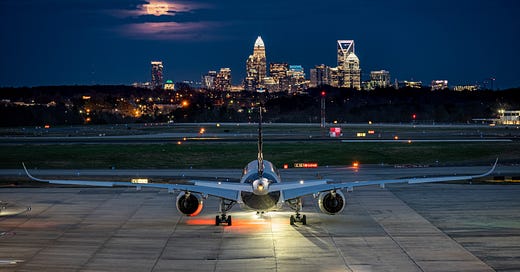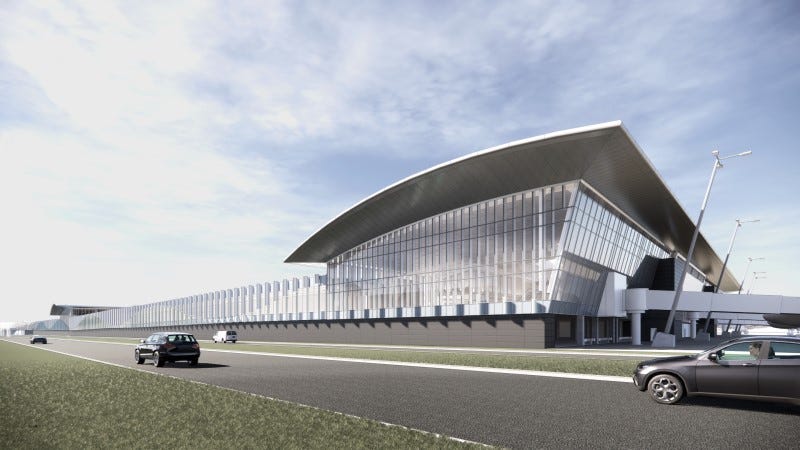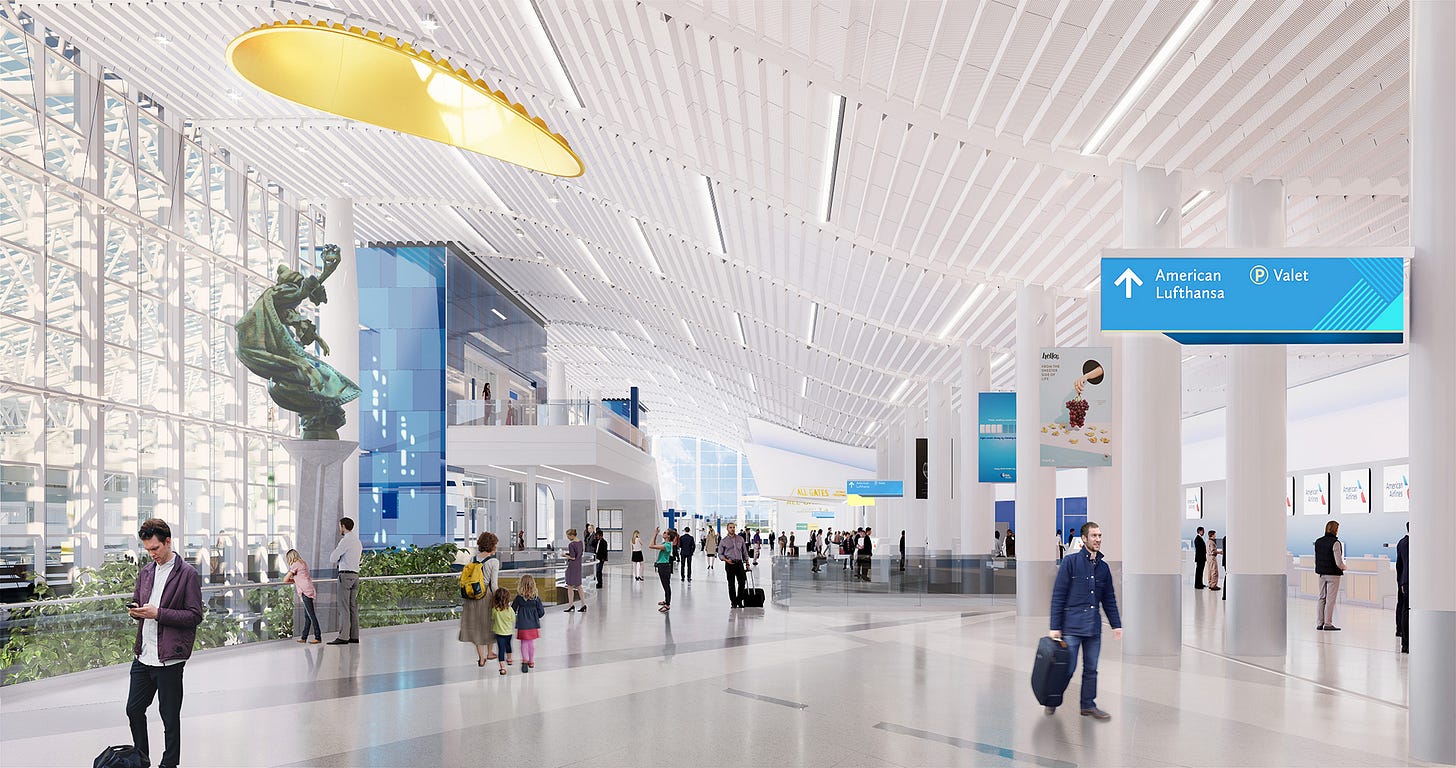You’re reading Transit Time, a weekly newsletter for Charlotte people who leave the house. Cars, buses, light rail, bikes, scooters … if you use it to get around the city, we write about it. Transit Time is produced in partnership between The Charlotte Ledger and WFAE.
One of Charlotte’s top economic engines has big ideas for growth; ‘We have plans to have plans’
(Photo by Myles Gelbach)
You probably know that there’s a lot happening at Charlotte’s airport.
It’s the seventh-busiest in the world in terms of takeoffs and landings. It handles more than 118,000 passengers a day.
But it’s not done growing. Not even close.
Today, we’re sharing a portion of a conversation with two experts on topics including:
Why the airport still matters for economic development in the era of remote work
All the construction that’s underway — and what comes next
Whether CLT will ever have a people-mover train
And, of course, those rocking chairs
The conversation comes from a podcast we recorded this month with two experts who know a lot about the airport’s plans for the future — and how it fits into larger changes in aviation: Stuart Hair, the Charlotte airport’s director of commercial and community engagement; and Ben Goebel, aviation design expert with architecture firm Gresham Smith.
➡️ Hair and Goebel are also going to be panelists at an upcoming conference you should know about: The South Charlotte Partners Regional Transportation Summit. It’s on Sept. 11 at The Ballantyne hotel and features an impressive lineup of speakers including N.C. Secretary of Transportation Eric Boyette, Charlotte Mayor Vi Lyles, American Airlines’ Tracy Montross and many others from federal, state and local government who are on the front lines of local transportation issues. The Transit Time newsletter is the media partner for the event.
You can find out more and register here.

Today’s conversation with Hair and Goebel is the latest episode of The Charlotte Ledger Podcast, which talks with local leaders about interesting and important local topics. We release new episodes weekly. This interview was conducted by The Ledger’s Tony Mecia.
The Charlotte Ledger Podcast is available on our website, as well as on podcast platforms including Apple Podcasts, Spotify, Overcast and Google Podcasts. (The audio of this episode is available at the top of this email.)
Here are some of the highlights of the conversation with Hair and Goebel about the future of Charlotte’s airport. It is edited for length and clarity:
On whether there will always be construction at the airport:
Hair: I get that question frequently. And my general response is, as long as the community is growing and developing, our business model at the airport will respond to that growth and development. We don’t build for the future, in the sense that we’re thinking of, “Gosh, if we build it, they will come.”
We need to meet that demand right now. So that’s what our future stance is — that as long as our community is growing and developing, we’re always 5, 10, 15 years sometimes behind in meeting that demand. And that’s what a lot of the construction projects are about right now. They are meeting the demand that exists today.
Goebel: The one thing I’ve heard the airport talk a lot about is the philosophy they call rightsizing the airport — not trying to be too big or too small. Out of the whole aviation industry, CLT is one of the better airports about designing according to the right size.
Right now, there’s just a lot of construction going on. But as that’s built out, and you look at the master plan of the airport, a lot of the future phases, they won’t be so much customer-facing. If you look at some of the Concourse A expansion projects, a lot of the customers didn’t know that the construction that was occurring is for the airport. So if we can just get through this tough period, I think future expansion won’t be as painful for everyone.
On the airport as an economic development asset, even as remote work has increased:
Hair: It is very much still a primary economic driver. Whenever we talk with economic developers, it’s always one of the top three reasons why a company decides to relocate or expand in the Charlotte area. It may not be No. 1, especially with the change in the office dynamic. It generally is not No. 1 any longer. But it is generally always one of those top three reasons.
It’s not just the passenger connection, though that’s a big part of it. It’s also the connections that cargo is enabled on. And then the presence of the intermodal facility also allows another dynamic to go into their supply chain. It’s all about that supply chain resiliency, when it comes to manufacturing. And so it’s all of those factors together that really make the airport, its overall campus, such a driver for Charlotte and for the Carolinas as a whole.
On trends in airport design:
Goebel: One of the things that you’re going to really start to see — and it’s really already started — is all of my clients are really trying to push for a sense of place. They’re really looking at “How does my airport become that first and last impression of the city or the region?”
There’s no desire any longer to get that cookie-cutter, clean metal building, that all looks the same. CLT has different influences — textile history, the farming and agriculture of North Carolina — there are all sorts of great different influences from Charlotte, and then the Carolinas as a whole that are brought into the design.
Like other airports, Charlotte has worked to ensure that local vendors can sell goods that are distinctively from Charlotte and the Carolinas. (Photo courtesy of Charlotte/Douglas International Airport)
Passengers aren’t super interested in going to — and this is no offense to those fast food chains — but they’re not that crazy about going to McDonald’s. They’d rather go to a Midwood Smokehouse. If they’re in Charlotte, they want to get a little bit of that local flair and flavor while they’re in a particular airport. So that’s what we’re really seeing the most, is that airports are really driving to create that sense of place and reflect that region that they serve.
On the significance of the Charlotte airport’s rocking chairs:
Hair: That came about through a public art piece. We had a public art piece a number of years ago in the early ’80s, when the terminal opened up, and we used Southern front porches to kind of activate the terminal lobby. Rocking chairs were part of it. They were so popular that we just kind of adopted it as a brand.
We always get questions about them. And I think that we will continue them as a brand for the foreseeable future. I think they’re a great amenity and a neat way to differentiate Charlotte.
On whether the Charlotte airport will ever need a tram or people-mover like other large airports:
Hair: We have plans to have plans at Charlotte. We have an ultra-long-term vision. When we look at the connection between, say, Concourse A Expansion Phase II that will be opening up next year — primarily leased out to Delta — and somebody going from that new expansion to the refurbished and revitalized E Concourses — which are the regional gates that American primarily has leased — that’s about a 3-mile walk between those.
So yeah, we have plans to have plans to maybe have a connection between the various arms of the terminal. In addition, when we look at expansion options, and adding on to the B and C concourses and maybe doing a midfield concourse, at some point, there would be probably additional infrastructure — a tram, moving sidewalks — who knows what technology would develop in the next 10 or 15 years?
The airport continues to expand Concourse A. The $231M Concourse A Expansion Phase II is expected to open next year and will add 10 gates. (Rendering courtesy of Charlotte/Douglas International Airport)
But we do have that type of long-term vision. We don’t have to make that decision today. But the decisions that we make today could prevent us from being able to make that decision in the future. And so we’re being very intentional in decisions that we’re making today, so that we can do something in the future if the demand is there.
On congestion on Concourses B and C:
Hair: From an operational standpoint, they are as well-used as they can be. Realistically, without relocating gates, there’s not a whole lot that we can do. And anytime that we’re talking about moving gates, we’re talking about impacting operations.
The current thinking along B and C is to make an expansion at the end of the B and C concourses to add on additional gates so that additional planes can utilize them, and that we can free up some of the flow through B and C, so that people are not standing in the hold room space right there at a gate and it spills over into the walkway. So we think an expansion at the end of B and C might free up some of that space. But realistically, until we have the capacity to move gates, there’s not a whole lot that we can do.
Goebel: In terms of the experience of B and C, CLT is not the only airport experiencing that. This is really an industry-wide issue. A lot of it’s being driven by trends in the way the airlines service their customers.
There’s also an upcoming pilot shortage. If we have fewer pilots, airlines are going to be interested in flying more flights with more people, and the only way you do that is with larger aircraft. And if you look at the time that concourses B and C were designed, candidly, smaller aircraft with fewer people per flight were going in and out of there.
If we’re able to do some of the expansions that Stuart is talking about and pick up some additional gates, we can strategically relieve that pressure off of B and C, and then that frees us up and gives us the opportunity to do some improvement projects.
On the Terminal Lobby Expansion project, and when the Queen Charlotte statue will return:
Goebel: Before the holiday season comes up, you’ll see a brand new security checkpoint open. We’re slating to have that open in late October or early November, and we’ll have a big media day. That same media day is when we’re going to unveil the queen. So late October — be on the lookout. We will see Queen Charlotte unveiled.
The entire project is currently scheduled to be completely finished in 2025. But most of the public-facing things you’ll see will happen before that.
The statue of Queen Charlotte is expected to be unveiled this fall in the airport’s renovated and expanded terminal lobby. That project is scheduled to be complete in 2025. (Rendering courtesy of Charlotte/Douglas International Airport)
On plans for a “Destination District” by the airport’s entrance on Wilkinson Boulevard:
Hair: We anticipate within the next six months, we will be doing some public offerings of land for development. And we have some real firm ideas as to what type of development we want in that space — not office, not residential. I’ll tell you that right away.
We have some real ideas of land that we’re going to be offering for development, right at Wilkinson and North Josh Birmingham Parkway, right at the front door of the airport. And we have about 40 acres on one side, about 20 acres on another side that we’ll be seeking development partners with to develop that Destination District.
The Destination District is happening. Like with any commercial development project, it does take a while to get going. And you want to get people excited about it.
We’re looking at commercial uses. There’s demand right now that’s not being met by the private market for additional commercial development right at the front door of the airport. Now, part of that is very frankly — we own the land. And so we are wanting to seek additional non-aeronautical revenue opportunities. We are financially self-sufficient. And so just like we charge for parking, we are going to charge to develop our property.
We had held off on some initial plans, because of the timing of the light rail. When the Silver Line was being planned, initially, we thought that that would be a catalytic project that we would be talking about. Due to Covid and various other reasons, it’s not going to happen within the foreseeable future, to have light rail in the Destination District. So we’ve had to kind of go back in and redo some of those plans.
For more of the discussion — including the airport’s outlook on growth, its efforts to keep costs down, the effect of a new runway under construction, an update on the expansion of the A Concourse and how the airport works with its neighbors — check out the podcast.
Related Ledger video:
🎥 Video: “Inside the airport’s biggest construction project” (May 26, 2021 — with The 5 and 2 Project)
Again, if you need more info about the South Charlotte Partners Regional Transportation Summit — Sept. 11, 2023, at The Ballantyne hotel — check it out and register here.
Transit Time is a production of The Charlotte Ledger and WFAE. You can adjust your newsletter preferences on the ‘My Account’ page.
Did somebody forward you this newsletter and you need to sign up? You can do that here:
Other affiliated Charlotte newsletters and podcasts that might interest you:
The Charlotte Ledger Business Newsletter, Ways of Life newsletter (obituaries) and Fútbol Friday (Charlotte FC), available from The Charlotte Ledger.
The Inside Politics newsletter, available from WFAE.

















Share this post